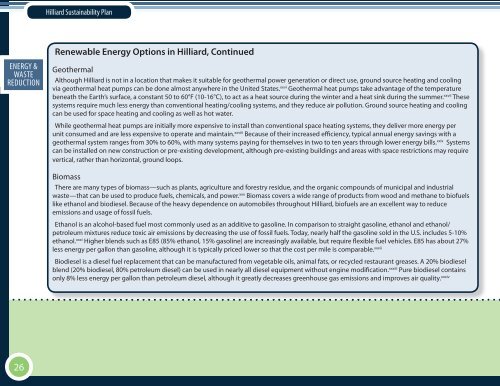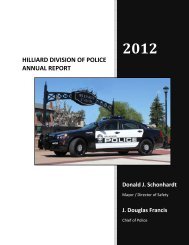The City of Hilliard Sustainability Plan
The City of Hilliard Sustainability Plan
The City of Hilliard Sustainability Plan
Create successful ePaper yourself
Turn your PDF publications into a flip-book with our unique Google optimized e-Paper software.
<strong>Hilliard</strong> <strong>Sustainability</strong> <strong>Plan</strong>ECON. EXECUTIVEENERGY DEV. &SOCIAL SUMMARY WASTE EQ.REDUCTIONRenewable Energy Options in <strong>Hilliard</strong>, ContinuedGeothermalAlthough <strong>Hilliard</strong> is not in a location that makes it suitable for geothermal power generation or direct use, ground source heating and coolingvia geothermal heat pumps can be done almost anywhere in the United States. xxvi Geothermal heat pumps take advantage <strong>of</strong> the temperaturebeneath the Earth’s surface, a constant 50 to 60°F (10-16°C), to act as a heat source during the winter and a heat sink during the summer. xxvii <strong>The</strong>sesystems require much less energy than conventional heating/cooling systems, and they reduce air pollution. Ground source heating and coolingcan be used for space heating and cooling as well as hot water.While geothermal heat pumps are initially more expensive to install than conventional space heating systems, they deliver more energy perunit consumed and are less expensive to operate and maintain. xxviii Because <strong>of</strong> their increased efficiency, typical annual energy savings with ageothermal system ranges from 30% to 60%, with many systems paying for themselves in two to ten years through lower energy bills. xxix Systemscan be installed on new construction or pre-existing development, although pre-existing buildings and areas with space restrictions may requirevertical, rather than horizontal, ground loops.Biomass<strong>The</strong>re are many types <strong>of</strong> biomass—such as plants, agriculture and forestry residue, and the organic compounds <strong>of</strong> municipal and industrialwaste—that can be used to produce fuels, chemicals, and power. xxx Biomass covers a wide range <strong>of</strong> products from wood and methane to bi<strong>of</strong>uelslike ethanol and biodiesel. Because <strong>of</strong> the heavy dependence on automobiles throughout <strong>Hilliard</strong>, bi<strong>of</strong>uels are an excellent way to reduceemissions and usage <strong>of</strong> fossil fuels.Ethanol is an alcohol-based fuel most commonly used as an additive to gasoline. In comparison to straight gasoline, ethanol and ethanol/petroleum mixtures reduce toxic air emissions by decreasing the use <strong>of</strong> fossil fuels. Today, nearly half the gasoline sold in the U.S. includes 5-10%ethanol. xxxi Higher blends such as E85 (85% ethanol, 15% gasoline) are increasingly available, but require flexible fuel vehicles. E85 has about 27%less energy per gallon than gasoline, although it is typically priced lower so that the cost per mile is comparable. xxxiiBiodiesel is a diesel fuel replacement that can be manufactured from vegetable oils, animal fats, or recycled restaurant greases. A 20% biodieselblend (20% biodiesel, 80% petroleum diesel) can be used in nearly all diesel equipment without engine modification. xxxiii Pure biodiesel containsonly 8% less energy per gallon than petroleum diesel, although it greatly decreases greenhouse gas emissions and improves air quality. xxxiv26






